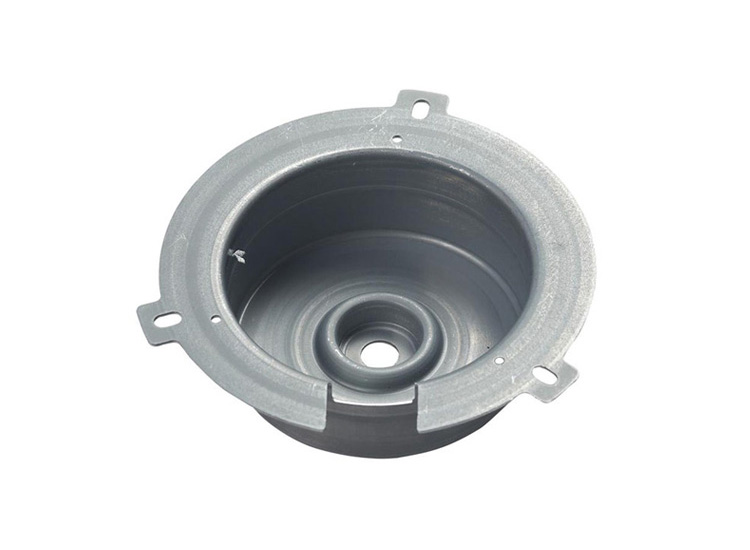The main ones are as follows:
1. The blanking is not smooth: when assembling the mold, there is no leakage, or rolling and blocking the shit, the foot is blocking the shit, which is the most common, and the assembly master is most likely to occur if he does not pay attention to it, like when the blanking hole is many, or when the mold has a pad.
2. Design process: the mold strength is not enough, the knife edge spacing is too close, the mold structure is unreasonable, and the number of template blocks is not enough
(1) Layout and edge: unreasonable reciprocating feeding layout method, as well as too small edge value, often cause sharp mold wear or convex, concave die gnawing. Reasonable selection of layout method and edge value to improve die life.
(2) The accuracy of the guiding mechanism of the mold: accurate and reliable guiding, which has a great impact on reducing the wear of the working parts of the mold and avoiding the gnawing of the convex and concave dies, especially the non-gap and small gap punching dies, composite dies and multi-station progressive dies are more effective. In order to improve the life of the mold, it is necessary to correctly select the guiding form and determine the accuracy of the guiding mechanism according to the requirements of the nature of the process and the accuracy of the parts.
(3) Geometric parameters of the cutting edge of the die (convex and concave die).
3. Heat treatment: improper quenching and tempering process produces deformation
Practice has proved that the hot working quality of the die has a great influence on the performance and service life of the die. According to the analysis and statistics of the cause of mold failure, the "accident" of mold failure caused by improper heat treatment accounts for more than 40%.
(1) Forging process: This is an important part of the mold work parts manufacturing process. For the die of high alloy tool steel, the technical requirements for metallographic structure such as material carbide distribution are usually put forward.
(2) Preparatory heat treatment: according to the different materials and requirements of the working parts of the mold, the preparatory heat treatment process such as annealing, normalizing or tempering should be used to improve the organization, eliminate the organization defects of the forged blank, and improve the processing technology. High carbon alloy die steel after appropriate preparatory heat treatment, can eliminate the network of secondary cementite or chain carbide, carbide spheroidization, refinement, promote the uniformity of carbide distribution, which is conducive to ensure the quenching, tempering quality, improve the life of the die.
(3) Quenching and tempering: this is the key link in the mold heat treatment. If overheating occurs during quenching heating, it will not only cause greater brittleness of the workpiece, but also easily cause deformation and cracking during cooling, which seriously affects the life of the die. Die quenching heating should pay special attention to prevent oxidation and decarbonization, should strictly control the heat treatment process specifications, in the case of conditions permit, vacuum heat treatment can be used. Tempering should be done in time after quenching, and different tempering processes should be used according to technical requirements.
(4) Stress relief annealing: After the rough machining of the mold working parts, the stress relief annealing treatment should be carried out, the purpose is to eliminate the internal stress caused by the rough machining, so as to avoid excessive deformation and cracks during quenching. For molds with high precision requirements, stress relief tempering treatment is also required after grinding or electric machining, which is conducive to stable mold accuracy and improve service life.
4. Mold grinding flatness is not enough, resulting in deflection
The surface quality of the working parts of the mold has a very close relationship with the wear resistance, fracture resistance and adhesion resistance of the mold, which directly affects the service life of the mold, especially the surface roughness value has a great impact on the life of the mold. If the surface roughness value is too large, it will produce stress concentration phenomenon at work, and cracks are easy to occur between its peak and valley, affecting the durability of the die, but also affect the corrosion resistance of the workpiece surface, and directly affect the service life and accuracy of the die. Therefore, the following matters should be noted:
(1) In the process of machining mold working parts, it is necessary to prevent the surface phenomenon of grinding burned parts, and the grinding process conditions and process methods should be strictly controlled (such as grinding wheel hardness, particle size, coolant, feed rate and other parameters);
(2) In the process of processing, it should be prevented from leaving macroscopic defects such as knife marks, interlayers, cracks, and impact scars on the surface of the working parts of the mold. The existence of these defects will cause stress concentration and become the root cause of fracture, resulting in early failure of the mold;
(3) The use of grinding, grinding and polishing and other finishing and fine processing, to obtain a small surface roughness value, improve the service life of the mold
5. Improper line cutting: Pull the wire line cutting, the gap is wrong, did not make a clear Angle
Artificially pulling the wire and cutting the line, the line cutting gap treatment is not correct, and the influence of the cleaning Angle and the metamorphic layer of the line cutting is not done. The cutting edge of the die is mostly wire cutting. Due to the thermal effect and electrolytic effect of wire cutting processing, the die processing surface produces a certain thickness of metamorphic layer, resulting in surface hardness reduction, micro-cracks, etc., resulting in early wear of the die of wire cutting processing, which directly affects the maintenance of the die punching gap and the edge is easy to break, shortening the service life of the die. Therefore, in the wire cutting processing, a reasonable electrical gauge should be selected to minimize the depth of the metamorphic layer.
6. Selection of punching equipment: punching tonnage, punching force is not enough, and the mold is too deep
The tonnage of the punching machine, the punching force is not enough, and the mold is too deep. The accuracy and rigidity of stamping equipment (such as presses) are extremely important to the impact of die life. The stamping equipment has high precision and good rigidity, and the life of the die is greatly improved. For example, the complex silicon steel die material is Crl2MoV, which is used in ordinary open press with an average regrinding life of 10-30,000 times; The new precision press is used, and the regrinding life of the die can reach 60,000-120,000 times.
7. Uneven stripping: no demagnetization treatment before production, no return tip; There are broken needles and broken springs in the production
8. The mold material is not good and it is easy to break in subsequent processing
9. Production awareness: laminated stamping, positioning is not in place, no blow gun is used, and the template continues to produce when there are cracks.
- Previous:The most common problem of hardware mold repair
- Next:No










